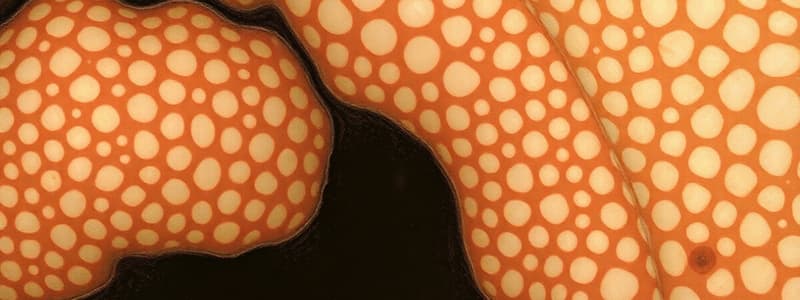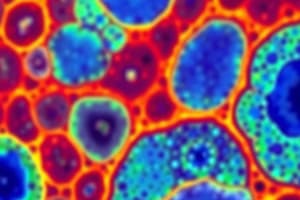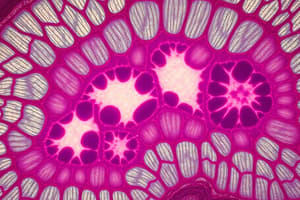Podcast
Questions and Answers
Which type of epithelium is characterized by a single layer of thin, flattened cells and is involved in filtration?
Which type of epithelium is characterized by a single layer of thin, flattened cells and is involved in filtration?
- Simple columnar epithelium
- Simple cuboidal epithelium
- Stratified squamous epithelium
- Simple squamous epithelium (correct)
What is the primary function of simple cuboidal epithelium?
What is the primary function of simple cuboidal epithelium?
- Transport of oxygen
- Transpiration of moisture
- Protection against abrasion
- Absorption, secretion, or excretion (correct)
Which structure is responsible for binding the cell membrane to the basement membrane in epithelial cells?
Which structure is responsible for binding the cell membrane to the basement membrane in epithelial cells?
- Microvilli
- Folds of plasma membrane
- Hemidesmosomes (correct)
- Cilia
What is a distinguishing feature of pseudostratified epithelium?
What is a distinguishing feature of pseudostratified epithelium?
Which epithelial type commonly features microvilli to increase its surface area for absorption?
Which epithelial type commonly features microvilli to increase its surface area for absorption?
What are the primary characteristics used to classify lining epithelia?
What are the primary characteristics used to classify lining epithelia?
Which component of the hemidesmosome attaches to intermediate filaments in the epithelial cell?
Which component of the hemidesmosome attaches to intermediate filaments in the epithelial cell?
Stratified squamous epithelium is best suited for which of the following functions?
Stratified squamous epithelium is best suited for which of the following functions?
What is the primary function of microvilli?
What is the primary function of microvilli?
Which structure is primarily responsible for the rhythmic movement that helps move substances in the respiratory tract?
Which structure is primarily responsible for the rhythmic movement that helps move substances in the respiratory tract?
In which part of the body would you primarily find stereocilia?
In which part of the body would you primarily find stereocilia?
What is a primary function of epithelial tissue?
What is a primary function of epithelial tissue?
What role does keratin play in epithelial cells?
What role does keratin play in epithelial cells?
Which type of cellular junction forms a continuous band around the perimeter of epithelial cells?
Which type of cellular junction forms a continuous band around the perimeter of epithelial cells?
Which domain of epithelial cells faces the external environment?
Which domain of epithelial cells faces the external environment?
What is a key characteristic of lining epithelia?
What is a key characteristic of lining epithelia?
How are epithelial cells primarily nourished?
How are epithelial cells primarily nourished?
What are microvilli primarily involved in?
What are microvilli primarily involved in?
How do adherent junctions differ from occlusive junctions?
How do adherent junctions differ from occlusive junctions?
What characteristic is unique to epithelial tissue?
What characteristic is unique to epithelial tissue?
What happens to keratin filaments after the epithelial cell dies?
What happens to keratin filaments after the epithelial cell dies?
Which type of apical specialization is NOT typically found in epithelial cells?
Which type of apical specialization is NOT typically found in epithelial cells?
What important structural feature separates epithelial tissue from underlying connective tissue?
What important structural feature separates epithelial tissue from underlying connective tissue?
Which of the following is NOT a function of epithelial tissue?
Which of the following is NOT a function of epithelial tissue?
What proteins primarily facilitate the sealing action of tight junctions?
What proteins primarily facilitate the sealing action of tight junctions?
Which junction type allows for the passage of ions and small molecules between cells?
Which junction type allows for the passage of ions and small molecules between cells?
What is the main structural characteristic of desmosomes?
What is the main structural characteristic of desmosomes?
What is the primary function of adherens junctions?
What is the primary function of adherens junctions?
Where are cadherins primarily located within adherens junctions?
Where are cadherins primarily located within adherens junctions?
Which type of junction is found randomly distributed across the plasma membrane?
Which type of junction is found randomly distributed across the plasma membrane?
What kind of proteins form the transmembrane channels in GAP junctions?
What kind of proteins form the transmembrane channels in GAP junctions?
What distinguishes the basement membrane from other junctions discussed?
What distinguishes the basement membrane from other junctions discussed?
What is the primary function of stratified squamous keratinized epithelium?
What is the primary function of stratified squamous keratinized epithelium?
Where can pseudostratified columnar epithelium predominantly be found?
Where can pseudostratified columnar epithelium predominantly be found?
Which type of epithelial cells is characterized by multiple layers of cuboidal cells?
Which type of epithelial cells is characterized by multiple layers of cuboidal cells?
Which type of epithelium is primarily involved in lining and protecting various internal surfaces?
Which type of epithelium is primarily involved in lining and protecting various internal surfaces?
Which type of glands does not possess an excretory duct?
Which type of glands does not possess an excretory duct?
What unique characteristic does urothelium (transitional epithelium) exhibit?
What unique characteristic does urothelium (transitional epithelium) exhibit?
What is the function of stratified columnar epithelium?
What is the function of stratified columnar epithelium?
Which feature distinguishes glandular epithelia from other epithelial types?
Which feature distinguishes glandular epithelia from other epithelial types?
Which type of gland releases secretion products through exocytosis?
Which type of gland releases secretion products through exocytosis?
What classification is based on the shape of the secretory part of exocrine glands?
What classification is based on the shape of the secretory part of exocrine glands?
Which of the following is NOT a characteristic of endocrine glands?
Which of the following is NOT a characteristic of endocrine glands?
Which type of gland secretes a product that includes cell components along with the secretion?
Which type of gland secretes a product that includes cell components along with the secretion?
How are follicular endocrine glands organized?
How are follicular endocrine glands organized?
What type of secretion is associated with goblet cells?
What type of secretion is associated with goblet cells?
Which of the following describes the role of cordonal endocrine glands?
Which of the following describes the role of cordonal endocrine glands?
Which type of gland contains both exocrine and endocrine functions in the human body?
Which type of gland contains both exocrine and endocrine functions in the human body?
Flashcards
Microvilli
Microvilli
Finger-like projections extending from the apical surface of epithelial cells, increasing surface area for absorption.
Enterocytes
Enterocytes
Specialized epithelial cells in the small intestine responsible for nutrient absorption.
Cilia
Cilia
Hair-like structures that extend from the surface of epithelial cells, involved in movement of fluids and particles.
Stereocilia
Stereocilia
Signup and view all the flashcards
Keratin
Keratin
Signup and view all the flashcards
Zonula
Zonula
Signup and view all the flashcards
Macula
Macula
Signup and view all the flashcards
Occlusive junctions
Occlusive junctions
Signup and view all the flashcards
Epithelial tissue: Key function
Epithelial tissue: Key function
Signup and view all the flashcards
Epithelial tissue: Avascularity
Epithelial tissue: Avascularity
Signup and view all the flashcards
Epithelial tissue: Basement membrane
Epithelial tissue: Basement membrane
Signup and view all the flashcards
Epithelial cell: Apical Domain
Epithelial cell: Apical Domain
Signup and view all the flashcards
Epithelial cell: Basal Domain
Epithelial cell: Basal Domain
Signup and view all the flashcards
Epithelial cell: Lateral Domains
Epithelial cell: Lateral Domains
Signup and view all the flashcards
Microvilli: Function
Microvilli: Function
Signup and view all the flashcards
Cilia: Function
Cilia: Function
Signup and view all the flashcards
Exocrine Glands
Exocrine Glands
Signup and view all the flashcards
Simple Exocrine Gland
Simple Exocrine Gland
Signup and view all the flashcards
Compound Exocrine Gland
Compound Exocrine Gland
Signup and view all the flashcards
Branched Exocrine Gland
Branched Exocrine Gland
Signup and view all the flashcards
Tubular Exocrine Gland
Tubular Exocrine Gland
Signup and view all the flashcards
Acinar Exocrine Gland
Acinar Exocrine Gland
Signup and view all the flashcards
Alveolar Exocrine Gland
Alveolar Exocrine Gland
Signup and view all the flashcards
Endocrine Glands
Endocrine Glands
Signup and view all the flashcards
Zonula occludens (tight junction)
Zonula occludens (tight junction)
Signup and view all the flashcards
Occludins and Claudins
Occludins and Claudins
Signup and view all the flashcards
Zonula Adherens (adherens junction)
Zonula Adherens (adherens junction)
Signup and view all the flashcards
Cadherins
Cadherins
Signup and view all the flashcards
Desmosomes (Macula adherens)
Desmosomes (Macula adherens)
Signup and view all the flashcards
Folds
Folds
Signup and view all the flashcards
Hemidesmosomes
Hemidesmosomes
Signup and view all the flashcards
Communicating (GAP) junctions or nexus
Communicating (GAP) junctions or nexus
Signup and view all the flashcards
Lining Epithelium
Lining Epithelium
Signup and view all the flashcards
Basement membrane
Basement membrane
Signup and view all the flashcards
Connexins
Connexins
Signup and view all the flashcards
Simple Squamous Epithelium
Simple Squamous Epithelium
Signup and view all the flashcards
Simple Cuboidal Epithelium
Simple Cuboidal Epithelium
Signup and view all the flashcards
Simple Columnar Epithelium
Simple Columnar Epithelium
Signup and view all the flashcards
Stratified Squamous Epithelium
Stratified Squamous Epithelium
Signup and view all the flashcards
Stratified Squamous Keratinized Epithelium
Stratified Squamous Keratinized Epithelium
Signup and view all the flashcards
Stratified Cuboidal Epithelium
Stratified Cuboidal Epithelium
Signup and view all the flashcards
Stratified Columnar Epithelium
Stratified Columnar Epithelium
Signup and view all the flashcards
Pseudostratified Columnar Epithelium
Pseudostratified Columnar Epithelium
Signup and view all the flashcards
Urothelium (Transitional Epithelium)
Urothelium (Transitional Epithelium)
Signup and view all the flashcards
Mucosal Epithelium
Mucosal Epithelium
Signup and view all the flashcards
Study Notes
Epithelial Tissue
- Epithelial tissue covers internal and external body surfaces, lines cavities, and forms glands.
- Cells are tightly connected by junctional complexes, minimizing extracellular space.
- Nourishment comes from underlying connective tissue.
- Separated from connective tissue by a basement membrane.
Functions of Epithelial Tissue
- Delimitation: Forming surfaces and lining cavities (Lining Epithelium)
- Protection: Protecting underlying structures
- Diffusion: Regulating molecular exchange between compartments
- Absorption: Taking in substances
- Filtration: Separating substances
- Excretion: Removing substances
- Reception of stimuli: Detecting changes
- Secretion: Producing and releasing glandular products (hormones, enzymes) - secretory glands
Epithelial Cell Polarity
- Epithelial cells are polarized: structurally and functionally different domains.
- Basal domain: Attaches to the basement membrane.
- Apical domain: Faces the lumen (cavity) or external environment.
- Lateral domains: Face adjacent cells.
- Cell features vary depending on function in these domains.
Apical Membrane Specializations
- The apical domain faces the lumen.
- Contains numerous ion channels and transport proteins for secretion.
- Specialized structures, like microvilli, cilia, and stereocilia, are present, related to its function.
- Microvilli: Membrane-covered cytoplasmic extensions formed by actin filaments, increasing cell surface for absorption in the small intestine and renal tubules.
- Cilia: Larger membrane extensions composed of microtubule doublets and a central pair; for movement of substances in the respiratory tract.
- Stereocilia: Modified microvilli, sensory structures for movement in the male reproductive tract.
- Keratin: Protein providing structural support and rigidity, making it resistant to damage. Fills dead cells in stratified squamous epithelium increasing resistance and impermeability.
Lateral Membrane Specializations
- Cells are tightly joined by junctional complexes in lining epithelia.
- Extracellular matrix is minimal
- Tight Junctions (Zonula Occludens): Prevent substance passage between cells; seals space between cell membranes.
- Adherens Junctions (Zonula Adherens): Attach cells together; anchor actin filaments to cytoskeleton to keep cells tightly joined.
- Desmosomes (Macula Adherens): Provide strong adhesion between cells; intermediate filaments interact with dense plates within the cell.
- Gap Junctions (Nexus): Channels forming pores between cells; allowing passage of small molecules (ions) between cytoplasm of adjacent cells.
Basal Membrane Specializations
- The basal membrane is located at the base of epithelial cells and separates them from the underlying connective tissue.
- Folds: Increases surface area for transport and contact with neighboring cells.
- Hemidesmosomes: Bind epithelial cells to the basement membrane.
- Provide structural support and anchoring strength. They incorporate intermediate filaments of keratin in their dense plates.
Classification of Epithelia
- Two main types:
- Lining Epithelia: Classified by cell layers (simple, stratified, pseudostratified) and cell shapes (squamous, cuboidal, columnar) and surface specializations (microvilli, cilia, stereocilia, keratin).
- Glandular Epithelia (Glands): Produce and secrete substances. Classified by whether there are ducts (exocrine) or not (endocrine).
Number of Cells
- Unicellular: Made of a single cell (ex: goblet cell).
- Multicellular: Composed of multiple cells (ex: salivary glands).
Types of Secretion
- Merocrine: Secretion released by exocytosis (most common).
- Holocrine: Secretory cells disintegrate; releasing their contents (ex: sebaceous glands).
- Apocrine: Secretory cell releases portion of cytoplasm in addition to the product (ex: mammary glands).
Nature of Secretion
- Mucous: Secretion forms mucus
- Serous: Secretes enzymes
- Mixed: Contains both mucous and serous components.
Types of Glands
- Exocrine: Secrete into ducts or the exterior
- Classified according to duct structure (Simple, Compound, Branched) and secretory portion shape (Tubular, Acinar/Alveolar).
- Endocrine: Secrete hormones directly into blood.
- Classified into Cordonal (arranged in cords/groups) and Follicular (hollow structures).
Anficrins Glands
- Some glands (e.g., pancreas, liver) have combined exocrine and endocrine properties.
Studying That Suits You
Use AI to generate personalized quizzes and flashcards to suit your learning preferences.




